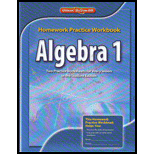
Concept explainers
a)
To write: a function to represent the sequence.
a)
Answer to Problem 30PPS
A function to represent the sequenceis
Explanation of Solution
Given:
An arithmetic sequence is given as:
281, 270, 259, 248, …
The sequence represents the total number of ounces the box weighs as each book is taken out.
Calculation:
Consider the given terms.
281, 270, 259, 248, …
Now, find the common difference of the sequence as shown:
The sequence is decreasing, so the common difference is positive:
Write the equation for the nth term of an arithmetic sequence using the first term 281 and common difference
So, the function to represent the sequence is
b)
To find: the weight of each year book.
b)
Answer to Problem 30PPS
The weight of each yearbook is 11 ounces.
Explanation of Solution
Given:
An arithmetic sequence is given as:
281, 270, 259, 248, …
The sequence represents the total number of ounces the box weighs as each book is taken out.
Calculation:
Consider the given terms.
281, 270, 259, 248, …
Now, find the common difference of the sequence as shown:
The sequence is decreasing, so the common difference is positive:
The weight decreases by 11 ounce every time a book is taken out, so the common difference represents the weight of each yearbook, or 11 ounces.
c)
To find: the number of yearbooks in a full box.
c)
Answer to Problem 30PPS
The number of yearbooks in a full boxis 25.
Explanation of Solution
Given:
An arithmetic sequence is given as:
281, 270, 259, 248, …
The sequence represents the total number of ounces the box weighs as each book is taken out.
Empty box weight 17 ounces and full box weighs 292 ounces.
Calculation:
Consider the given terms.
281, 270, 259, 248, …
Now, subtract the weight of the empty box from the weight of the full box.
Now, divide by the weight by 11 to get number yearbook
So, there are 25 books in a full box.
d)
To find: the domain and range of the function obtained in part (a).
d)
Answer to Problem 30PPS
The domain of the function is
The range of the function is
Explanation of Solution
Given:
An arithmetic sequence is given as:
281, 270, 259, 248, …
The sequence represents the total number of ounces the box weighs as each book is taken out.
Empty box weight 17 ounces and full box weighs 292 ounces.
Calculation:
Consider the given terms.
281, 270, 259, 248, …
Now, subtract the weight of the empty box from the weight of the full box.
Now, divide by the weight by 11 to get number yearbook
So, there are 25 books in a full box.
The domain of the function is the number books. So, the domain is
The range of the function is weighs of books.
Chapter 3 Solutions
Algebra 1, Homework Practice Workbook (MERRILL ALGEBRA 1)
Additional Math Textbook Solutions
Basic Business Statistics, Student Value Edition
Intro Stats, Books a la Carte Edition (5th Edition)
A Problem Solving Approach To Mathematics For Elementary School Teachers (13th Edition)
Elementary Statistics (13th Edition)
- Listen A falling object travels a distance given by the formula d = 6t + 9t2 where d is in feet and t is the time in seconds. How many seconds will it take for the object to travel 112 feet? Round answer to 2 decimal places. (Write the number, not the units). Your Answer:arrow_forwardSolve by the quadratic formula or completing the square to obtain exact solutions. 2 e 104 OA) -16±3√6 B) 8±√10 O c) -8±√10 OD) 8±3√√6 Uarrow_forwardQuestion 14 (1 point) Listen The frame on a picture is 18 in by 22 in outside and is of uniform width. Using algebraic methods, what is the width of the frame if the inner area of the picture shown is 250 in²2? Write answer to 2 decimal places. (Write the number with no units). 18 in Your Answer: 22 inarrow_forward
- ◄ Listen A vacant lot is being converted into a community garden. The garden and a walkway around its perimeter have an area of 560 square feet. Find the width of the walkway (x) if the garden measures 15 feet wide by 19 feet long. Write answer to 2 decimal places. (Write the number without units). X 15 feet Your Answer: 19 feet Xarrow_forwardListen A stuntman jumps from a roof 440 feet from the ground. How long will it take him to reach the ground? Use the formula, distance, d = 16t2, (where t is in seconds). Write answer to 1 decimal place. (Write the number, not the units). Your Answer:arrow_forwardSolve x² - 10x + 24 = 0 ○ A) 4,6 B) -12, -2 C) 12,2 D) -4, -6arrow_forward
 Algebra and Trigonometry (6th Edition)AlgebraISBN:9780134463216Author:Robert F. BlitzerPublisher:PEARSON
Algebra and Trigonometry (6th Edition)AlgebraISBN:9780134463216Author:Robert F. BlitzerPublisher:PEARSON Contemporary Abstract AlgebraAlgebraISBN:9781305657960Author:Joseph GallianPublisher:Cengage Learning
Contemporary Abstract AlgebraAlgebraISBN:9781305657960Author:Joseph GallianPublisher:Cengage Learning Linear Algebra: A Modern IntroductionAlgebraISBN:9781285463247Author:David PoolePublisher:Cengage Learning
Linear Algebra: A Modern IntroductionAlgebraISBN:9781285463247Author:David PoolePublisher:Cengage Learning Algebra And Trigonometry (11th Edition)AlgebraISBN:9780135163078Author:Michael SullivanPublisher:PEARSON
Algebra And Trigonometry (11th Edition)AlgebraISBN:9780135163078Author:Michael SullivanPublisher:PEARSON Introduction to Linear Algebra, Fifth EditionAlgebraISBN:9780980232776Author:Gilbert StrangPublisher:Wellesley-Cambridge Press
Introduction to Linear Algebra, Fifth EditionAlgebraISBN:9780980232776Author:Gilbert StrangPublisher:Wellesley-Cambridge Press College Algebra (Collegiate Math)AlgebraISBN:9780077836344Author:Julie Miller, Donna GerkenPublisher:McGraw-Hill Education
College Algebra (Collegiate Math)AlgebraISBN:9780077836344Author:Julie Miller, Donna GerkenPublisher:McGraw-Hill Education





